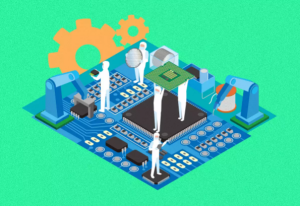The Indian semiconductor industry is projected to reach USD 55 billion by 2026. To address the global semiconductor shortage, the Indian government has established the India Semiconductor Mission (ISM), which includes four key schemes aimed at building a global hub for semiconductor manufacturing.
Prime Minister Narendra Modi has emphasized the country’s evolving role in technology, stating, “India is already a digital power, nuclear power, and space power; soon India will become an Electronic Power.” The vision of a “Made in India” and “Designed in India” semiconductor powerhouse underscores the nation’s ambition to lead in this critical sector.
To achieve this, India aims to overcome technological challenges, build a skilled workforce, create a resilient supply chain, and develop green energy solutions for sustainable manufacturing. At the heart of all advanced technologies—such as the Internet of Things (IoT), artificial intelligence (AI), nanotechnology, image processing, and augmented reality—lies electronics, making the semiconductor industry a crucial aspect of the global economy.
By investing in and prioritizing the semiconductor sector, India seeks to solidify its position as a key player in the global technology landscape.
Strong Ambitions Fostering Economic Growth
India is striking remarkable streaks in the semiconductor industry, reflecting strong ambitions fostering substantial economic growth. Here are the key developments:
1. Upcoming Semiconductor Manufacturing Units:
India plans to establish three new semiconductor manufacturing units with an investment of ₹1.26 lakh crore. This major investment underscores the country’s commitment to becoming a global leader in chip manufacturing.
2. Renesas and IIT Hyderabad Collaboration:
Renesas and IIT Hyderabad have signed a three-year Memorandum of Understanding (MoU) to collaborate on research in VLSI (Very-Large-Scale Integration) and embedded semiconductor systems. This partnership aims to drive innovation and enhance research capabilities in India.
3. Tata Group’s Semiconductor ATMP Facility:
The Tata Group announced in March this year the setup of a semiconductor ATMP (Assembly, Testing, Marking, and Packaging) facility worth ₹27,000 crore. This facility is crucial for strengthening the semiconductor supply chain and boosting India’s manufacturing capabilities.
4. Government Initiatives: Semicon India:
Launched in 2021, the Semicon India initiative aims to develop a robust and sustainable semiconductor and display ecosystem in the country. This initiative highlights the government’s strategic focus on advancing the semiconductor industry.
5. Design Linked Incentive (DLI) Scheme:
The DLI scheme offers financial incentives and design infrastructure support for the entire semiconductor lifecycle, including integrated circuits (ICs), chipsets, system-on-chips (SoCs), systems and IP cores, and semiconductor-linked design. This scheme is designed to foster innovation and attract investments in semiconductor design and manufacturing.
6. Job Creation:
The semiconductor industry is expected to create at least 1 million jobs over the next decade, significantly contributing to economic growth and employment in the country.
These initiatives and investments demonstrate India’s determination to become a global semiconductor manufacturing hub, leveraging public and private sector efforts to achieve this ambitious goal.
On the Way to Become a Sustainable & Self-Reliant Electronics SuperPower
India’s journey towards becoming a sustainable and self-reliant electronics superpower is driven by several key initiatives and strategic policies to boost its electronics manufacturing capabilities, foster innovation, and ensure environmental sustainability. Here are some of the significant steps and factors contributing to this transformation:
· Government Initiatives and Policies
- Make in India: Launched in 2014, this initiative encourages companies to manufacture their products in India to boost indigenous production and reduce dependency on imports.
- Production Linked Incentive (PLI) Scheme: This scheme offers financial incentives to electronics manufacturers to boost domestic production and attract investments.
- National Policy on Electronics (NPE) 2019: The policy aims to position India as a global hub for Electronics System Design and Manufacturing (ESDM) by promoting the growth of the semiconductor and display industry.
- 4. Digital India: This campaign aims to ensure that government services are available to citizens electronically, promoting digital literacy and connectivity.
· Strengthening the Supply Chain
- Local Sourcing: Encouraging local sourcing of components to reduce reliance on imports.
- Semiconductor Manufacturing: Plans to set up semiconductor fabrication plants (fabs) in India to establish a strong semiconductor ecosystem.
- Electronics Manufacturing Clusters (EMCs): Establishing EMCs to provide state-of-the-art infrastructure and facilities to electronics manufacturers.
· Innovation and Research
- Research and Development: Promoting R&D in the electronics sector to drive innovation and develop cutting-edge technologies.
- Collaboration with Global Companies: Partnering with global technology companies to bring advanced manufacturing technologies and practices to India.
· Environmental Sustainability
- E-Waste Management: Implementing stringent e-waste management rules to ensure proper recycling and disposal of electronic waste.
- Green Manufacturing Practices: Encouraging the adoption of eco-friendly manufacturing practices to minimize the environmental impact.
- Renewable Energy: Promoting the use of renewable energy sources in electronics manufacturing processes to reduce the carbon footprint.
· Skill Development
- Skilling Initiatives: Launching programs to train the workforce in advanced manufacturing technologies and electronics design.
- Collaboration with Educational Institutions: Partnering with educational institutions to develop a skilled talent pool for the electronics industry.
· Global Competitiveness
- Improving Ease of Doing Business: Simplifying regulations and providing incentives to attract foreign investments.
- Export Promotion: Encouraging the export of Indian-made electronics to global markets.










